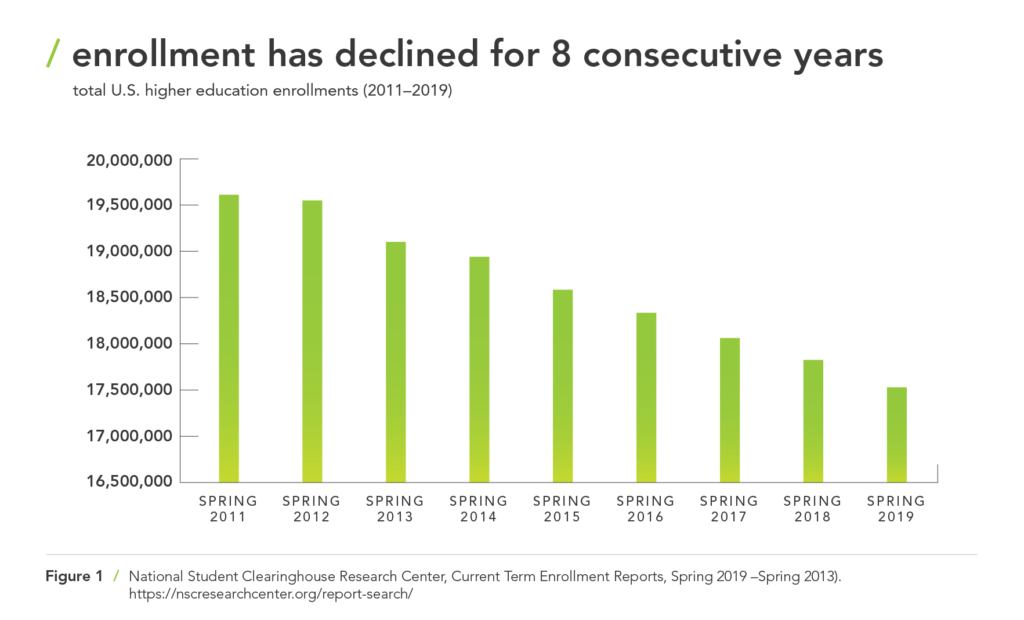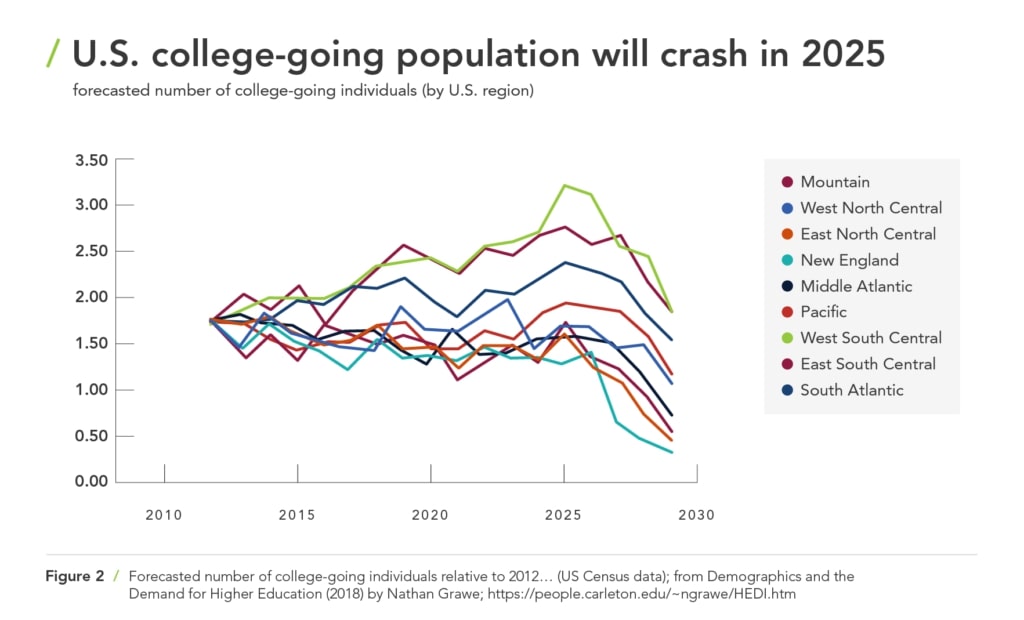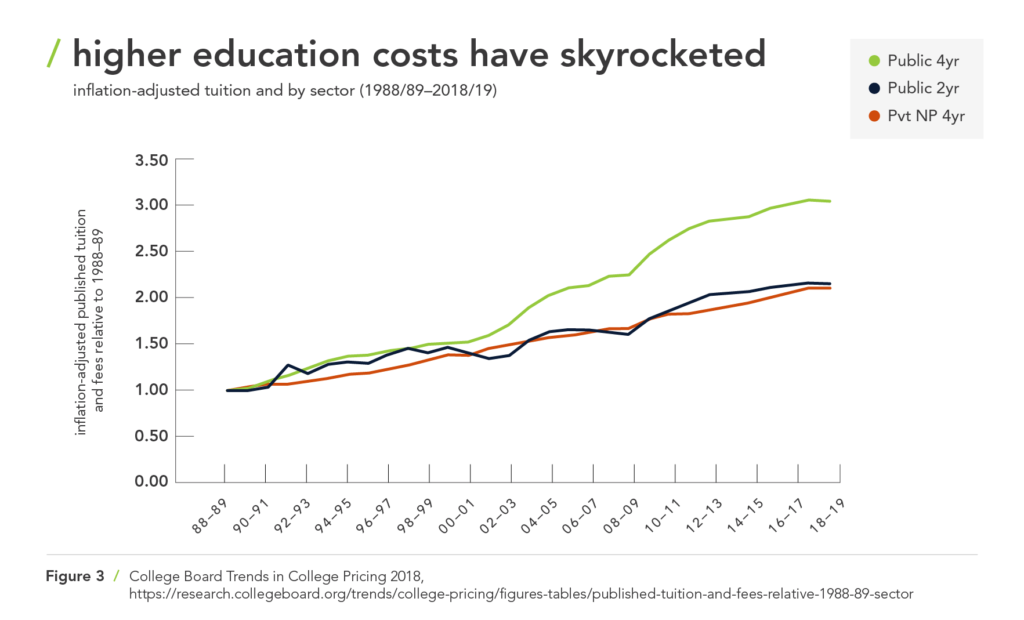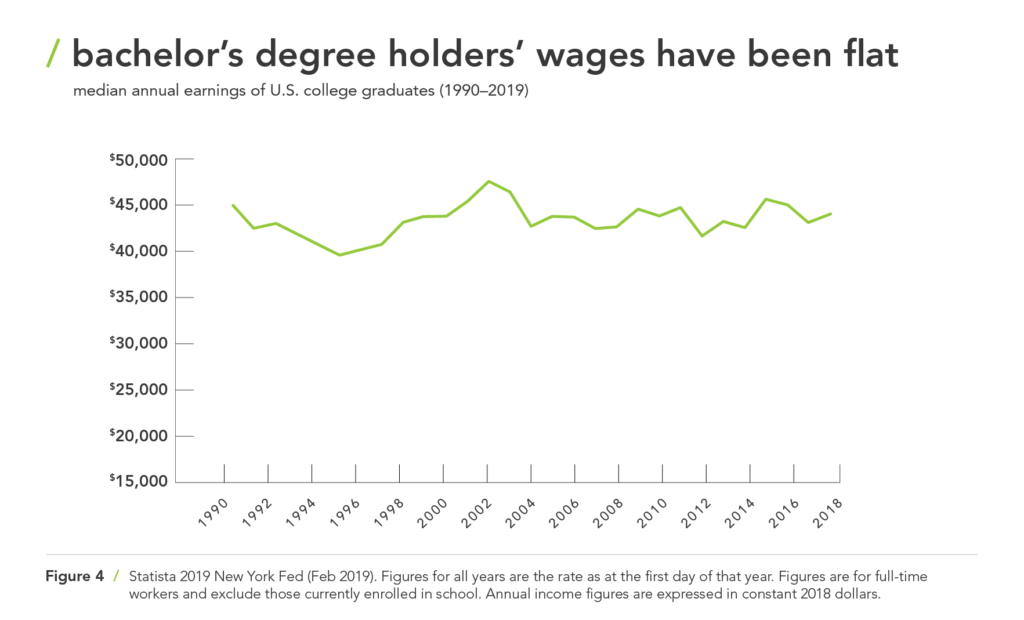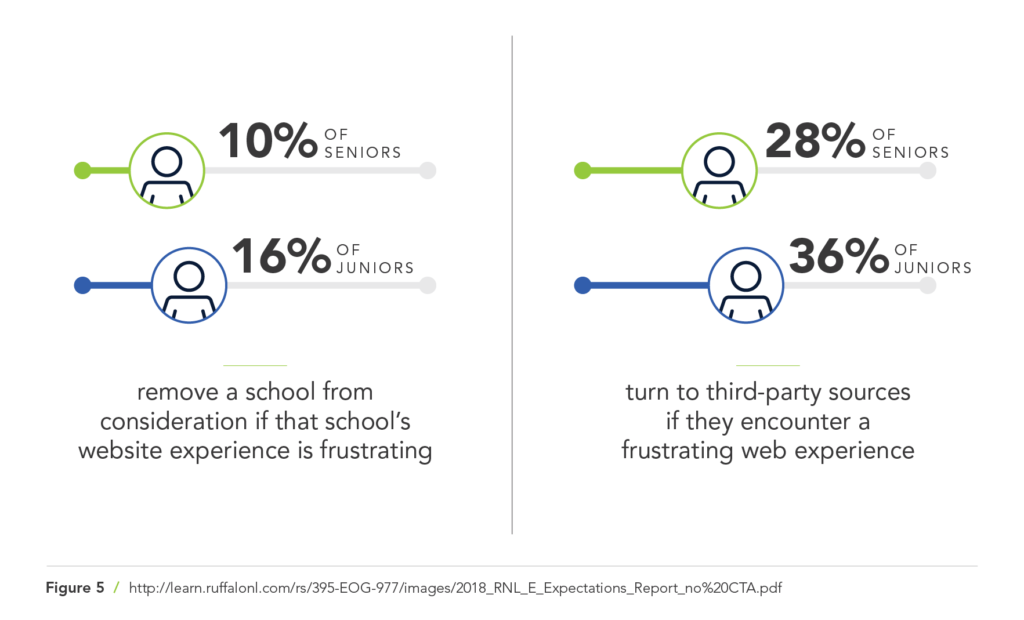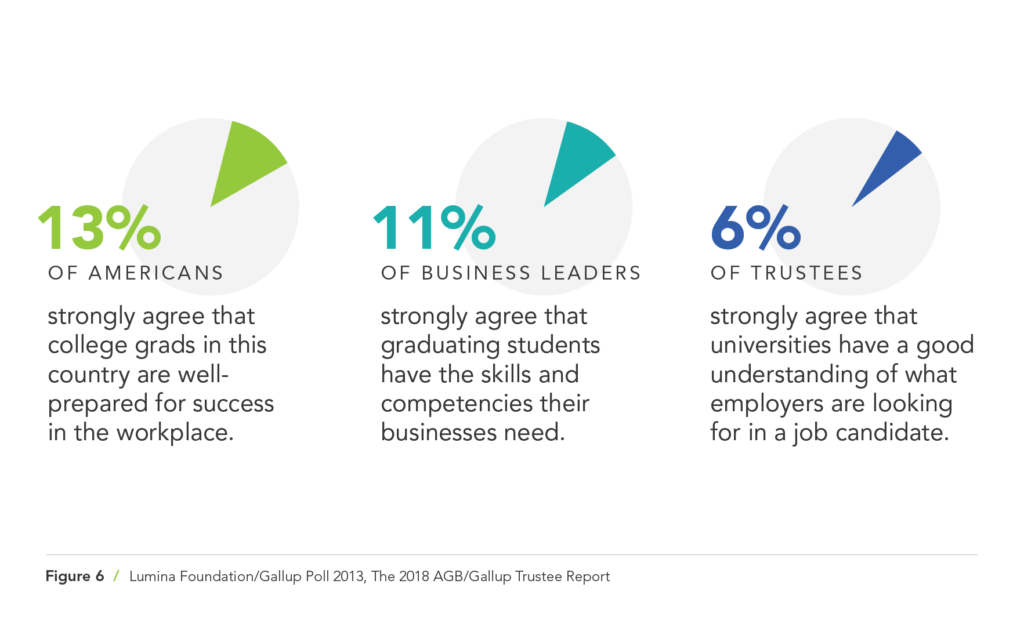The Crash. The Cliff. The Crisis in Higher Ed. If you follow current events and forecasts in the higher ed space, you’ve likely heard one, if not all, of these phrases recently and often. At least, that was my experience at the 2019 American Marketing Association Symposium for the Marketing of Higher Ed.
Nothing was more top of mind for recruitment marketing and admissions teams than this ominous topic, looming in their not-too-distant futures. Put simply, The Crisis in Higher Ed is the convergence of four trends, slated to come to a head in 2025:
- The population of college-aged adults is rapidly declining.
Total college enrollment has declined for eight straight years (see: Figure 1). Making matters worse, that trend isn’t expected to reverse any time soon. In fact, the number of college-aged adults is projected to fall into a tailspin across all regions starting in 2025 (see: Figure 2) . - The cost of higher education is out of hand.
College tuition and fees have risen an astonishing 393% since 1990 (see: Figure 3) while median annual wages of college graduates remaining relatively flat over the same time period—hovering at or below $45k except for a brief peak prior to the 2008 recession (see: Figure 4) . In 2025, analysts predict annual tuition to cross $100k at a handful of institutions with the University of Chicago’s sticker price being the first. - Modern students demand a more personalized recruitment experience.
Consumerization and its influence aren’t limited to retail. Prospective students disqualify institutions if the online experience is frustrating, average applications submitted by prospect has doubled in the last decade, and prospects are asking more nuanced questions around affordability, fit, and opportunity than ever before (see: Figure 5). Higher education has traditionally been slow to adapt, but the luxury of time isn’t afforded to modern institutions. - The public doesn’t trust universities to prepare students for life after college.
It’s long been true that Americans go to college in order to get a good job; that’s changing. That perception has been eroded beyond what you might imagined possible. Potentially most alarming: just 11% of business leaders strongly agree that graduating students have the skills and competencies their businesses need (see: Figure 6).
These trends are a clear call-to-action for leaders in higher education to do better, differentiate, or get left behind. And we’re not talking about next academic year— institutional survival requires immediate action in many cases. But my experience at AMA’s higher ed symposium lead me to believe those leaders are still overwhelmed by the massive challenge ahead of them.
In fact, the response I most often heard from higher ed leaders when asked about their approach to preparing for and overcoming The Cliff was almost always the same: “How do I drive change within my institution when I’m just in [marketing, enrollment, etc.]?”
My response to them? Something must change, and few are better positioned than those on the leading edge of the student experience: recruitment marketing and enrollment teams.
what you can do about it—even if you’re just in marketing or admissions
Brandon Busteed of Kaplan University Partners really set the tone for AMA Higher Ed 2019 in his opening keynote when he addressed the challenges outlined above head-on. He also set out a clear path forward to the higher ed leader trying to get ahead of the significant and rapid decline of college-aged adults: start thinking like a business leader and understand the levers you can pull to cut costs and expenses while creating revenue.
You have a responsibility to optimize your budget and drive stronger performance on behalf of your institution—just like your peers in business must maximize shareholder return. This shift in mindset recommended by Brandon is just the tip of the iceberg, though. To be successful as a higher ed leader in 2025 and beyond, I offer you three pieces of advice:
- Change your mindset
- Speak in the language of your customer
- Influence your institution’s product mix
change your mindset
In an article about the generation fallacy in higher ed, I described consumerization’s impact on prospective student expectations and the steps recruitment marketing and admissions leaders must take to deliver a better experience.
It’s time leaders in higher ed become comfortable with a simple fact I laid out in that piece: The student is your customer.
It’s time leaders in higher ed become comfortable with a simple fact I laid out in that piece: The student is your customer. And you can’t forget about your customer’s key influencers: parents, family, counselors, and peers.
Just referring to the student as a customer will classify you as revolutionary, maybe even offensive, amongst your colleagues. I can think of multiple times I’ve heard higher ed leaders correct marketers who referred to their students as customers. Times have changed; we need to accept reality.
Colleges and universities are asking prospective students and their families to, in many cases, make the biggest investment of their lives. With the prevalence of third-party research online, these potential buyers are doing their due diligence before making such a commitment.
Look no further than the sharp and recent decline in Requests for Information across higher ed as an example of the savviness of your audience. They’re shopping the same way you would for a house or car.
As a marketer, you can control the student experience from awareness through enrollment. So instead of thinking in terms like “I just work in enrollment” or “I’m just in recruitment marketing,” begin thinking “I am responsible for creating the best experience for our customer, the prospective student.”
To help get yourself in the appropriate mindset, ask yourself the following questions:
- How do prospective students and their families want to engage with me?
- How am I providing them with the information they need?
- How do we connect the experience on campus to their digital experience?
- Am I telling them what they want or telling them what I want?
speak in your customer’s language
As you think about the responses to those questions, remember to speak in your customer’s language. A few highlights that may surprise you from a recent Gallup survey:
- Your customer is losing trust in “universities” and “colleges,” say “higher education” instead.
- Regardless of what you’ve done in the past, avoid saying “liberal arts” at all costs—many respondents associate the term with politics and/or a limited career path.
What else are you hearing from your customers? Listen to their influencers: parents in the comments of your social posts, alumni who’ve become guidance counselors, the employers that will eventually hire them. Leverage your tools as a marketing and admissions leader to share the true voice of your student with institutional leadership.
influence your institution’s product mix
Influencing your institution’s product mix likely requires influencing your institution’s faculty. And while influencing faculty and their curriculum may seem impossible, the truth is: Institutions must find ways for students to apply their learnings from the classrooms to the jobs they’re preparing for. This is what your prospective students are telling you, but faculty might not be hearing.
In fact, it’s a primary driver of the substantial increase we’ve seen in online courses over the past decade: Adult learners—young and old—are seeking certificates and non-degree courses that provide an opportunity to develop real skills they can leverage to increase their earning potential. They’re not quiet about it. Has your institutional leadership taken the request to heart?
That’s just one example. As you begin to get more intimate with your customer, their motivations, and their aspirations, advocate for new products on their behalf. Yes, you can create new streams of revenue for your institution. It starts with sharing what you’re hearing from students with the rest of your institution to emphasize the urgent need.
Commit to being more than just your job title.
While broad institutional change does live with the president and requires many departments and teams coming together, there are things we can start doing to get ahead of 2025 and the higher ed crisis that’s scheduled to culminate then.
First, you must accept that you can drive change despite a lack of positional authority. Second, you must focus obsessively on your customer, the prospective student. And finally, you’ll need to help your institution deliver a product mix your customer is interested in investing in.
If you’re still struggling to move the needle at your institution despite your best efforts to operate as an advocate for your prospective student, it might be worth a conversation. I’ve helped recruitment marketing and admissions leaders across the country drive real, meaningful change in their organizations by connecting with their prospective students at scale. If you’d like to learn more, please reach out.
resources
The Atlantic: Some Colleges Could Soon Cost $100k
2018 RNL E-Expectations Report
Gallup: Higher Ed Should Drop the Term “Liberal Arts”

